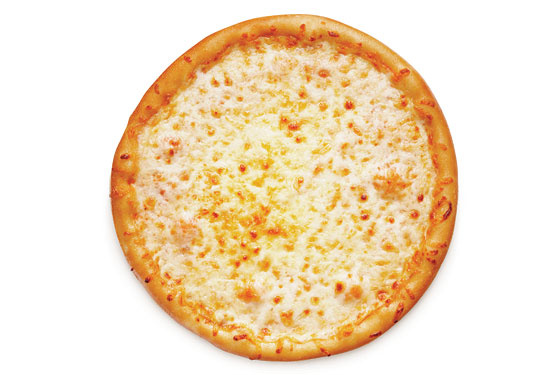
Reading the USDA’s new dietary guidelines, you notice a theme: Pizza is evil. The full, 95-page document makes it clear that there are few foods contributing more to our deadly corpulence, and so, the government tells us, we need to eat less of the stuff. This is not just another Bloombergian war on salt or trans fats. In this case, the USDA has aimed straight at America’s staff of life. As pizzaioli sob before their brick-oven altars, right-wing culture warriors must be giving thanks for yet another blessing: What better evidence that the Obama administration wants you, freethinking patriot, to submit to a life of locally grown, pepperoni-less unhappy meals?
The humble slice, we learn on pages 25 through 27 of the USDA’s report, is Americans’ No. 2 source of saturated fat and solid fats, largely because pizza is what the dairy industry might call an “effective cheese-delivery system.” Pizza is also the No. 3 source of sodium, beating out cold cuts and even bacon. After “grain-based desserts” like cakes and doughnuts, it’s the second-biggest source of calories for children and adolescents in a generation that has so far distinguished itself only on the scales.
Whether the USDA did so knowingly or not, the power of placing pizza in the crosshairs is that it speaks to everyone—from the guy in the La-Z-Boy downing a large Papa John’s while watching Mike & Molly to the folks who don’t ever touch soda or chips but will happily indulge in a pie with housemade meatballs and soppressata, paired with a quartino of a nice Barbarossa. What the government surely does realize is that the range of Americans who need that talking-to can also be demonstrated more simply, with hard numbers. About two thirds of adults are overweight or obese. Seventy-five percent are at risk of high blood pressure. Only 26 percent of adults eat vegetables three or more times a day, far short of existing national targets.
The problem has been that for 30 years, until the new guidelines were issued last Monday, the government has refused to brand specific foods—especially foods with powerful lobbies behind them—as the public-health enemies they can be. Instead, it translated its concerns into positive-eating messages. Eat less meat to help lower saturated-fat intake became “Eat more lean meats,” a politically correct statement that has proved utterly unpersuasive as dietary advice.
This timidity also left the field wide open to food marketers, who had no qualms about telling us how they think we should get our calories. The budget for the Center for Nutrition Policy and Promotion, the branch of the USDA responsible for writing and selling the dietary guidelines, is $9 million. By comparison, in 2009, according to Yale’s Rudd Center for Food Policy and Obesity, the fast-food industry spent $4.2 billion pitching offerings like Domino’s Wisconsin 6 Cheese pizza, a beast layered with mozzarella, Cheddar, provolone, Parmesan, feta, and Asiago—none, so far as anyone can tell, from Wisconsin—and Burger King’s 2,500-calorie pizza burger, formerly on sale at its Times Square Whopper Bar. Preschoolers see three commercials for fast food each day; teens see five. So much for the idea that it’s un-American for anyone to tell you what to eat.
And that’s also why, no matter how big a pro-pizza person you are, there’s a case to be made for this bit of nanny-statism, if only as a counterweight to the food-marketing onslaught and our genetic predisposition for the tantalizing combination of bread, sauce, and cheese. This isn’t a White House plot to take away your pizza. It’s an effort, and an uphill one at that, to save us from ourselves.
Have good intel? Send tips to intel@nymag.com.